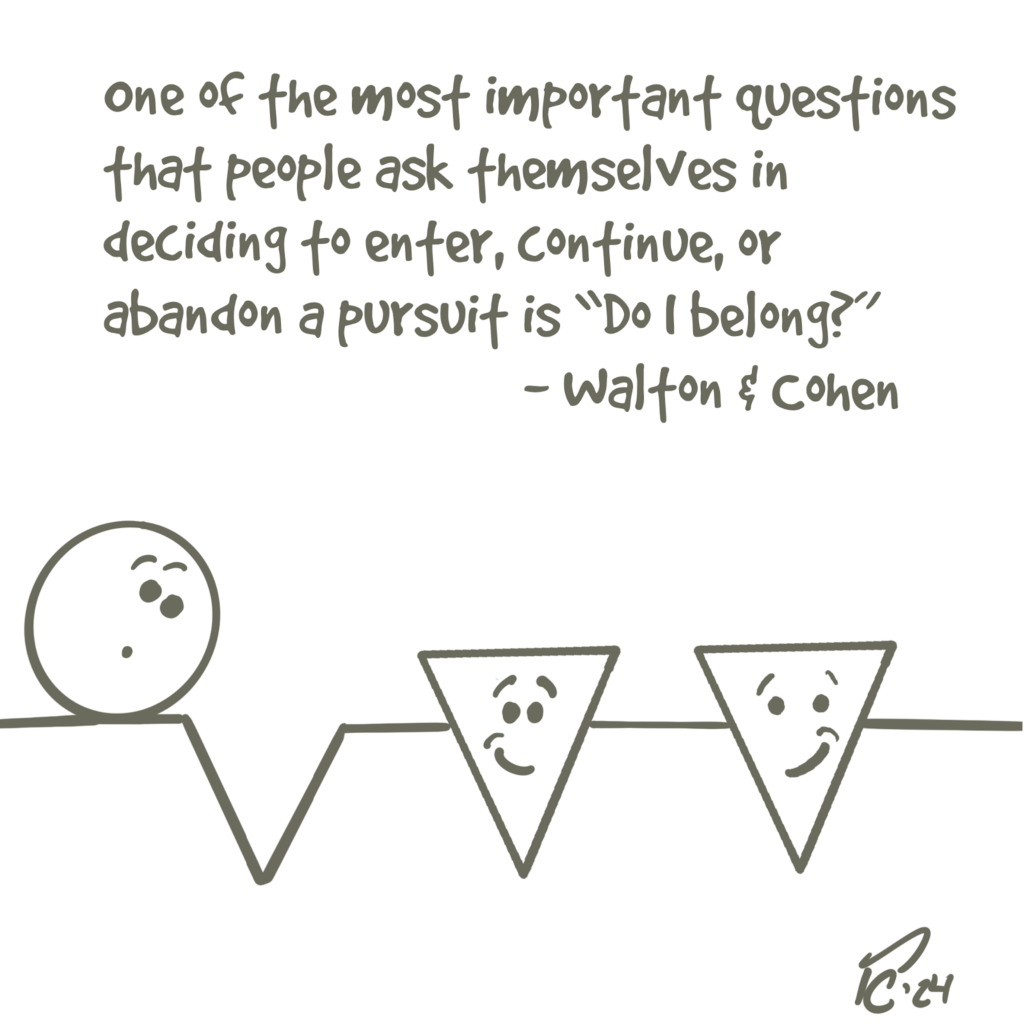By Amy Scheerhorn
As humans, we all need to feel like we belong. For students placed into developmental math, that sense of belonging may be missing. These students often feel out of place in a math class, which has negative implications for their academic success. A student’s sense of belonging impacts their attitudes, motivation, participation, engagement, and achievement. Teacher empathy plays a big role in helping students feel like they belong in the classroom, but finding a way to convey empathy to our students can be difficult. I developed a step-by-step approach to express empathy to my students and in turn foster their sense of belonging.

The quote is from Walton & Cohen, 2007, p. 94
To help students feel like they belong, students in my corequisite math support courses write in a weekly reflective journal, and I respond to their entries with empathy. Over time, students have shared that this process has helped them feel more connected to me and, in a bigger way, to the math community. When they write, they open up, and many have shared that they feel understood, valued, respected, or appreciated. Through these experiences, I’ve noticed students’ confidence grows and it is clear students are more comfortable learning and participating. You can find more details on how students experienced this sense of belonging in my research.
To make it easier to respond to student journal entries, I created a simple, step-by-step approach for writing empathetic feedback. I’ll share some student journal entries along with example responses that show how empathy can be expressed.
Student Journal Entries and Written Empathetic Feedback
Through my research, I found that I showed empathy in two main ways. First, by sharing my own personal or academic experiences. And second, by recognizing or acknowledging students for their understanding of math concepts, participation, work ethic, confidence, or even just their feelings.
First, a journal entry from Anna (pseudonym), a corequisite math student. Anna wrote, “I struggle with math truly, and it is something I am beyond anxious about in college. I still want to work hard and get my classes taken care of with a good GPA”.
An example of an empathetic written response, “I totally understand feeling anxious in college. I can relate as I remember wanting to work hard and get good grades, too. I had a scholarship in college that required me to maintain a certain GPA, so every semester, I was always worried about making sure my grades were good enough.”
Second, another journal entry from Anna later in the semester. Anna wrote, “My experience with math this week has been overall pretty positive. I have enjoyed working with my group. I like collaborating with them, because we all kind of have pieces of a puzzle and we bring it together to make one whole puzzle. I want to keep pushing ahead and learning more and more. I appreciate that we get to explain our thinking and have that included in our answers. It’s fun to see that everyone thinks differently.”.
An example of an empathetic written response, “I’ve noticed too that working with your group brings you joy. I agree with you about the benefits of group work -- like hearing different perspectives while solving problems and getting to verbalize your thinking. I notice that you collaborate well with your group in class. I can also see how hard you are working and that you are gaining confidence in your math skills.”
You may be wondering, but how can I write feedback like that myself? Here is a guide on getting started with a reflective journal in your own corequisite course.
How to Implement a Weekly Student Reflective Journal and Provide Written Empathetic Feedback
First, have your students create a Google Doc and share it with you. This will be the place where they write their journal entries, and where you’ll write your feedback. Make sure they give you editing rights as well. Weekly journal prompts are ideal. Set aside 10 to 15 minutes each week for students to write in their journal.
You’ll create your own journal prompts, focusing on how students feel and what they’re experiencing. Specifically, you can ask about their thoughts on math, your course in general, and their experiences in your math class. One prompt I like to start with is called, “My Math Story” where students write about their past experiences with math. Another one is, “Tell me about something that happened in math class this week and how it made you feel.”
Now, let’s talk about how to respond to the student journal entries.
- Read through the student’s journal entry and pay attention to any parts where they talk about their emotions.
- Restate the student’s emotion with an empathic phrase such as “I understand,” “I can see,” or “I can relate.”
- Look for any experiences that the student is describing.
- Restate the student’s experience, for example, “I understand feeling anxious in college”, or “I’ve noticed too that working with your group brings you joy.”
- Give the student some context and provide reasons for your understanding.
- Write about a personal or academic story from your own life, or
- Write about the student through acknowledging their understanding of math concepts, participation, work ethic, confidence, or feelings.
Writing empathetic feedback can be a challenge. It takes time each week to sit down and thoughtfully respond to student journal entries, and it can be mentally draining to craft meaningful replies. However, the benefits make it worthwhile. One of my students, Anna, shared that the feedback gave her a sense of connection and made her feel like she truly mattered. It’s clear from the responses I’ve gotten that students feel a sense of belonging when they receive thoughtful, empathetic feedback.

Amy Scheerhorn is a mathematics professor at Davenport University in Michigan, committed to fostering impactful learning experiences through collaborative, inquiry-based methods. Her research explores student belongingness and teacher empathy within the context of math classrooms.
